Economics of Public Policy Assignment: Analysis of UK Economy
VerifiedAdded on 2021/12/22
|9
|2098
|52
Homework Assignment
AI Summary
This economics assignment delves into the intricacies of public policy, examining the role of government intervention in the UK economy. The solution analyzes the impact of government actions on income distribution, market failures, and macroeconomic stability, considering both the advantages and disadvantages of such interventions. Furthermore, the assignment explores the differences between behavioral and neoclassical economics, contrasting their assumptions and policy applications, particularly concerning consumer choice and decision-making. The analysis extends to cost-benefit analysis, explaining its role in organizational decision-making, evaluating project rewards and risks, and preparing budgets. The assignment provides a comprehensive understanding of key economic concepts and their practical applications within the context of public policy.
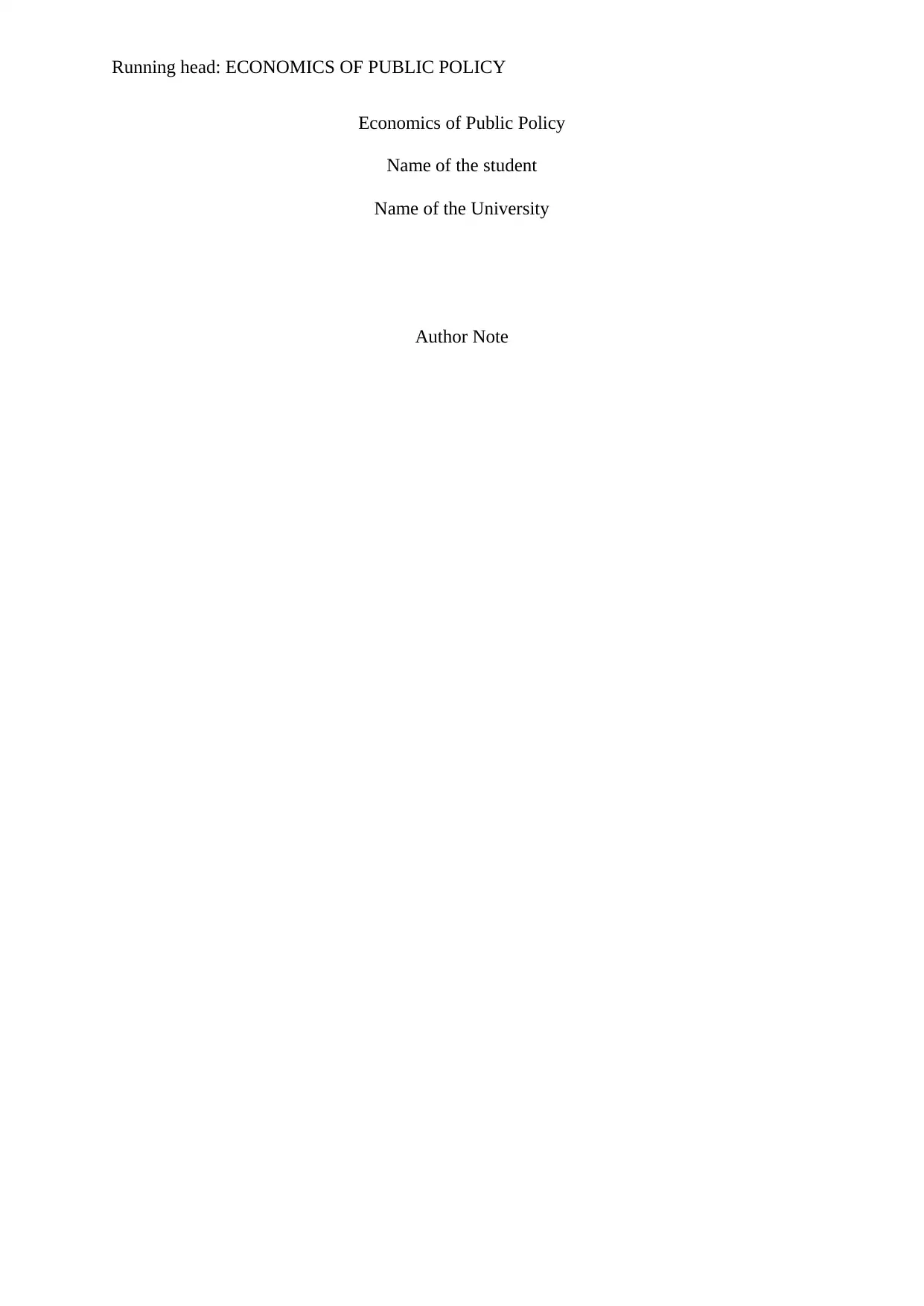
Running head: ECONOMICS OF PUBLIC POLICY
Economics of Public Policy
Name of the student
Name of the University
Author Note
Economics of Public Policy
Name of the student
Name of the University
Author Note
Paraphrase This Document
Need a fresh take? Get an instant paraphrase of this document with our AI Paraphraser

1ECONOMICS OF PUBLIC POLICY
Answer 2:
In economics, intervention of government and its magnitude is considered as an
essential topic to discuss. According to free market economists, government should not
intervene in any economic activities, as this activity can cause inefficient allocation of
resources while socialist economists always argue for government intervention (Joo, Seo and
Min 2018). Therefore, the entire discussion can be stated in the context of the United
Kingdom. If the government intervenes within the economy then the UK economy can
experience greater equality in income and wealth distribution. This in turn improves equality
of outcome and opportunity significantly. In addition to this, government failure can also
reduce the chance of market failure. The concept of market failure occurs when an economy
cannot allocate resource freely to produce specific goods and services. Therefore, market
failure causes welfare loss within economy (Baranzini and Carattini 2017). Firms in the UK
may produce public goods or merit goods by small amount through applying available
resources and produce private goods by large extend. In addition to this, intervention of the
government can be described with the help of macroeconomic concept. To reduce recession,
inflation, unemployment or other macroeconomic instability, the government can take fiscal
or monetary policies accordingly.
Therefore, government intervention in market intends to overcome market failure.
The chief focus of market failure includes price stability through applying minimum prices as
well as maximum prices. Within the free market economy, scarce resources are allocated
automatically based on price mechanism. In this context, the expenditure along with
preference decisions related to consumers as well as supply decisions of businesses help the
market to determine equilibrium price and quantity automatically. The UK government could
intervene within this market for influencing price mechanism significantly to allocate
Answer 2:
In economics, intervention of government and its magnitude is considered as an
essential topic to discuss. According to free market economists, government should not
intervene in any economic activities, as this activity can cause inefficient allocation of
resources while socialist economists always argue for government intervention (Joo, Seo and
Min 2018). Therefore, the entire discussion can be stated in the context of the United
Kingdom. If the government intervenes within the economy then the UK economy can
experience greater equality in income and wealth distribution. This in turn improves equality
of outcome and opportunity significantly. In addition to this, government failure can also
reduce the chance of market failure. The concept of market failure occurs when an economy
cannot allocate resource freely to produce specific goods and services. Therefore, market
failure causes welfare loss within economy (Baranzini and Carattini 2017). Firms in the UK
may produce public goods or merit goods by small amount through applying available
resources and produce private goods by large extend. In addition to this, intervention of the
government can be described with the help of macroeconomic concept. To reduce recession,
inflation, unemployment or other macroeconomic instability, the government can take fiscal
or monetary policies accordingly.
Therefore, government intervention in market intends to overcome market failure.
The chief focus of market failure includes price stability through applying minimum prices as
well as maximum prices. Within the free market economy, scarce resources are allocated
automatically based on price mechanism. In this context, the expenditure along with
preference decisions related to consumers as well as supply decisions of businesses help the
market to determine equilibrium price and quantity automatically. The UK government could
intervene within this market for influencing price mechanism significantly to allocate
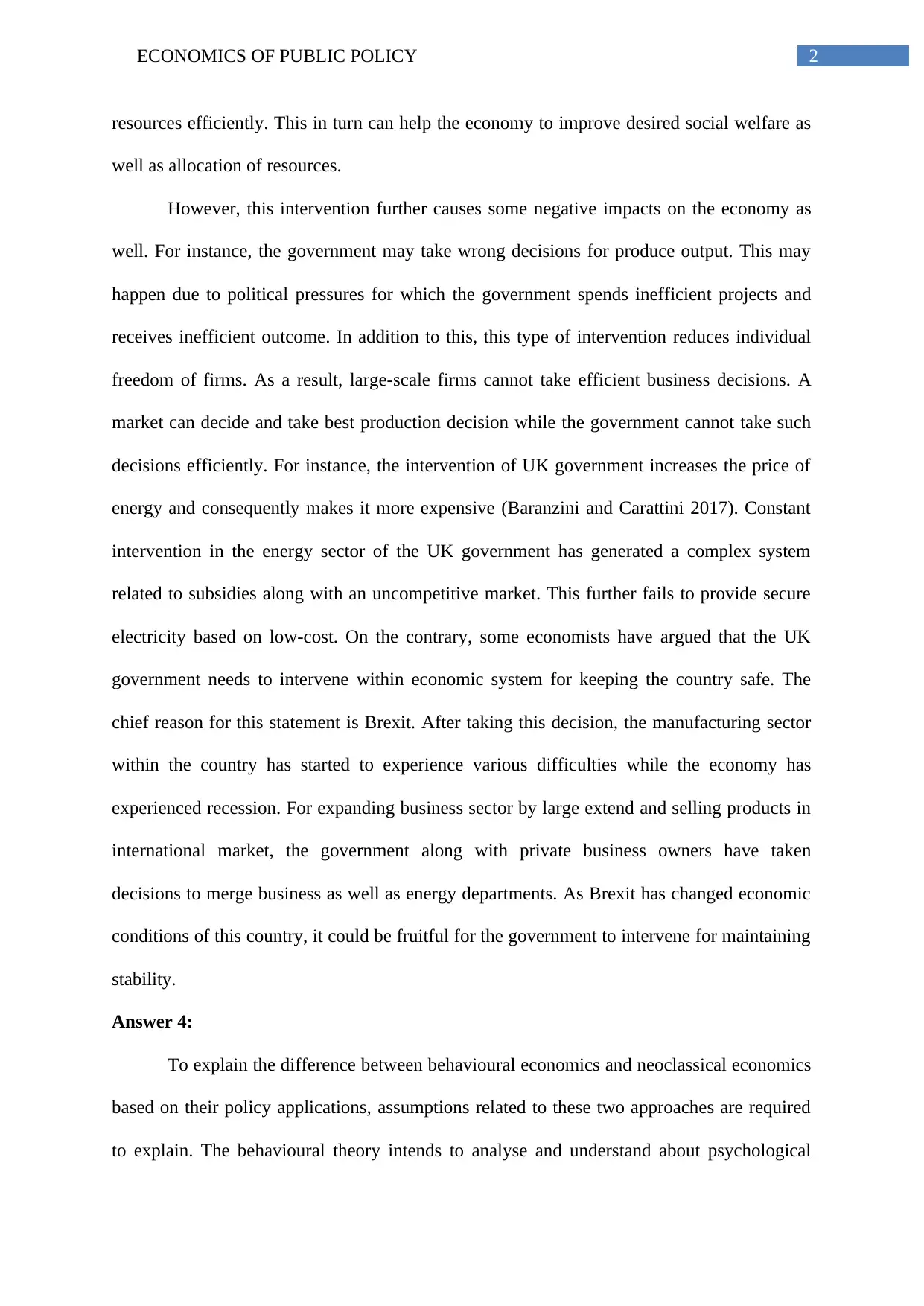
2ECONOMICS OF PUBLIC POLICY
resources efficiently. This in turn can help the economy to improve desired social welfare as
well as allocation of resources.
However, this intervention further causes some negative impacts on the economy as
well. For instance, the government may take wrong decisions for produce output. This may
happen due to political pressures for which the government spends inefficient projects and
receives inefficient outcome. In addition to this, this type of intervention reduces individual
freedom of firms. As a result, large-scale firms cannot take efficient business decisions. A
market can decide and take best production decision while the government cannot take such
decisions efficiently. For instance, the intervention of UK government increases the price of
energy and consequently makes it more expensive (Baranzini and Carattini 2017). Constant
intervention in the energy sector of the UK government has generated a complex system
related to subsidies along with an uncompetitive market. This further fails to provide secure
electricity based on low-cost. On the contrary, some economists have argued that the UK
government needs to intervene within economic system for keeping the country safe. The
chief reason for this statement is Brexit. After taking this decision, the manufacturing sector
within the country has started to experience various difficulties while the economy has
experienced recession. For expanding business sector by large extend and selling products in
international market, the government along with private business owners have taken
decisions to merge business as well as energy departments. As Brexit has changed economic
conditions of this country, it could be fruitful for the government to intervene for maintaining
stability.
Answer 4:
To explain the difference between behavioural economics and neoclassical economics
based on their policy applications, assumptions related to these two approaches are required
to explain. The behavioural theory intends to analyse and understand about psychological
resources efficiently. This in turn can help the economy to improve desired social welfare as
well as allocation of resources.
However, this intervention further causes some negative impacts on the economy as
well. For instance, the government may take wrong decisions for produce output. This may
happen due to political pressures for which the government spends inefficient projects and
receives inefficient outcome. In addition to this, this type of intervention reduces individual
freedom of firms. As a result, large-scale firms cannot take efficient business decisions. A
market can decide and take best production decision while the government cannot take such
decisions efficiently. For instance, the intervention of UK government increases the price of
energy and consequently makes it more expensive (Baranzini and Carattini 2017). Constant
intervention in the energy sector of the UK government has generated a complex system
related to subsidies along with an uncompetitive market. This further fails to provide secure
electricity based on low-cost. On the contrary, some economists have argued that the UK
government needs to intervene within economic system for keeping the country safe. The
chief reason for this statement is Brexit. After taking this decision, the manufacturing sector
within the country has started to experience various difficulties while the economy has
experienced recession. For expanding business sector by large extend and selling products in
international market, the government along with private business owners have taken
decisions to merge business as well as energy departments. As Brexit has changed economic
conditions of this country, it could be fruitful for the government to intervene for maintaining
stability.
Answer 4:
To explain the difference between behavioural economics and neoclassical economics
based on their policy applications, assumptions related to these two approaches are required
to explain. The behavioural theory intends to analyse and understand about psychological
⊘ This is a preview!⊘
Do you want full access?
Subscribe today to unlock all pages.

Trusted by 1+ million students worldwide

3ECONOMICS OF PUBLIC POLICY
process of an individual. These psychological processes consider emotions, habits and norms,
which further help an individual to take proper decision in different economic contexts (Pete
2014). On the other side, neoclassical economics discusses about the basic concepts of
demand and supply depending on the rationality of an individual. Depending on this ability, a
firm or individual can maximise utility or profit (Morgan 2015). For understating and
analysing various aspects, neoclassical economists consider mathematical discussions.
Neoclassical economists provide an inflexible, formalised as well as separate concept that can
be differentiate from other concepts of social science. On the other side, behavioural
economics considers that a person does not remain consistent with reality. This implies that a
person does not have sufficient knowledge regarding any economic phenomena. Therefore,
this type of economics enriches standard models that consider rigid assumptions that focus on
a person’s realistic behavioural attitude. In this context, it is essential to discuss about
indifference curve theory depending on the analysis of consumer choice (Barr 2012). This
economic concept highlights the behavioural approach of an individual to reflect his choice
for a bundle of good. Unlike neoclassical model, this indifference curve concept does not
consider any numerical approach, based on which utility of a consumer can be measured.
Therefore, this approach reflects an ordinal one instead of cardinal one.
Firstly, both behavioural and neoclassical economic theories consider that consumers
are rational and consequently they focus to maximise their utility. In this context, consumers
experience income constraint or budget constraint though the concerned person has complete
knowledge on information. Hence, based on rational thinking the consumer can take proper
decision. Secondly, consumers can successfully rank her preferred bundle of output based on
satisfaction, obtained from each basket (Pendakur 2018). The consumer may not calculate the
actual amount of satisfaction. However, the concerned person can arrange respective bundle
of goods through knowing the level of satisfaction obtaining from each of them. The
process of an individual. These psychological processes consider emotions, habits and norms,
which further help an individual to take proper decision in different economic contexts (Pete
2014). On the other side, neoclassical economics discusses about the basic concepts of
demand and supply depending on the rationality of an individual. Depending on this ability, a
firm or individual can maximise utility or profit (Morgan 2015). For understating and
analysing various aspects, neoclassical economists consider mathematical discussions.
Neoclassical economists provide an inflexible, formalised as well as separate concept that can
be differentiate from other concepts of social science. On the other side, behavioural
economics considers that a person does not remain consistent with reality. This implies that a
person does not have sufficient knowledge regarding any economic phenomena. Therefore,
this type of economics enriches standard models that consider rigid assumptions that focus on
a person’s realistic behavioural attitude. In this context, it is essential to discuss about
indifference curve theory depending on the analysis of consumer choice (Barr 2012). This
economic concept highlights the behavioural approach of an individual to reflect his choice
for a bundle of good. Unlike neoclassical model, this indifference curve concept does not
consider any numerical approach, based on which utility of a consumer can be measured.
Therefore, this approach reflects an ordinal one instead of cardinal one.
Firstly, both behavioural and neoclassical economic theories consider that consumers
are rational and consequently they focus to maximise their utility. In this context, consumers
experience income constraint or budget constraint though the concerned person has complete
knowledge on information. Hence, based on rational thinking the consumer can take proper
decision. Secondly, consumers can successfully rank her preferred bundle of output based on
satisfaction, obtained from each basket (Pendakur 2018). The consumer may not calculate the
actual amount of satisfaction. However, the concerned person can arrange respective bundle
of goods through knowing the level of satisfaction obtaining from each of them. The
Paraphrase This Document
Need a fresh take? Get an instant paraphrase of this document with our AI Paraphraser
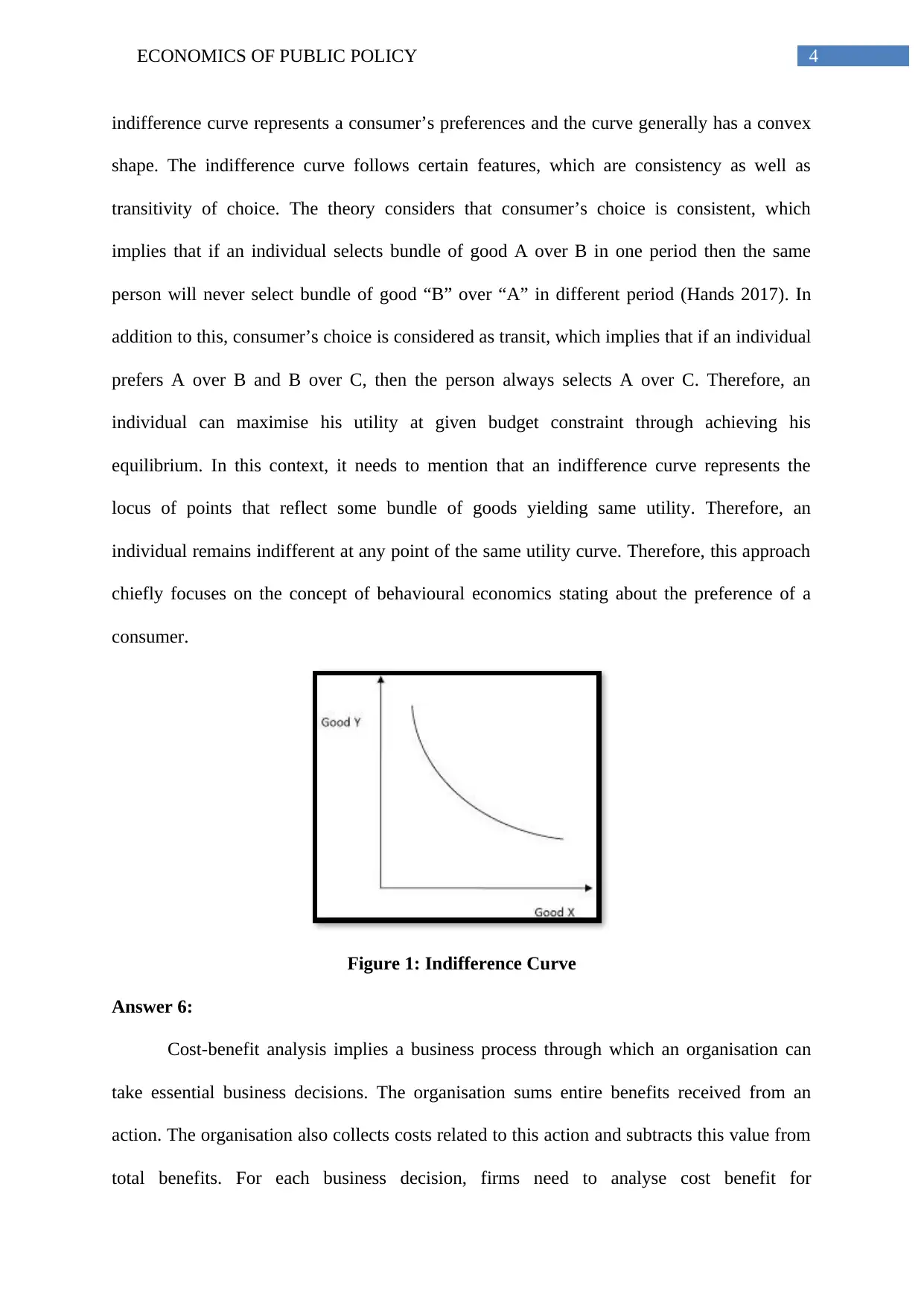
4ECONOMICS OF PUBLIC POLICY
indifference curve represents a consumer’s preferences and the curve generally has a convex
shape. The indifference curve follows certain features, which are consistency as well as
transitivity of choice. The theory considers that consumer’s choice is consistent, which
implies that if an individual selects bundle of good A over B in one period then the same
person will never select bundle of good “B” over “A” in different period (Hands 2017). In
addition to this, consumer’s choice is considered as transit, which implies that if an individual
prefers A over B and B over C, then the person always selects A over C. Therefore, an
individual can maximise his utility at given budget constraint through achieving his
equilibrium. In this context, it needs to mention that an indifference curve represents the
locus of points that reflect some bundle of goods yielding same utility. Therefore, an
individual remains indifferent at any point of the same utility curve. Therefore, this approach
chiefly focuses on the concept of behavioural economics stating about the preference of a
consumer.
Figure 1: Indifference Curve
Answer 6:
Cost-benefit analysis implies a business process through which an organisation can
take essential business decisions. The organisation sums entire benefits received from an
action. The organisation also collects costs related to this action and subtracts this value from
total benefits. For each business decision, firms need to analyse cost benefit for
indifference curve represents a consumer’s preferences and the curve generally has a convex
shape. The indifference curve follows certain features, which are consistency as well as
transitivity of choice. The theory considers that consumer’s choice is consistent, which
implies that if an individual selects bundle of good A over B in one period then the same
person will never select bundle of good “B” over “A” in different period (Hands 2017). In
addition to this, consumer’s choice is considered as transit, which implies that if an individual
prefers A over B and B over C, then the person always selects A over C. Therefore, an
individual can maximise his utility at given budget constraint through achieving his
equilibrium. In this context, it needs to mention that an indifference curve represents the
locus of points that reflect some bundle of goods yielding same utility. Therefore, an
individual remains indifferent at any point of the same utility curve. Therefore, this approach
chiefly focuses on the concept of behavioural economics stating about the preference of a
consumer.
Figure 1: Indifference Curve
Answer 6:
Cost-benefit analysis implies a business process through which an organisation can
take essential business decisions. The organisation sums entire benefits received from an
action. The organisation also collects costs related to this action and subtracts this value from
total benefits. For each business decision, firms need to analyse cost benefit for
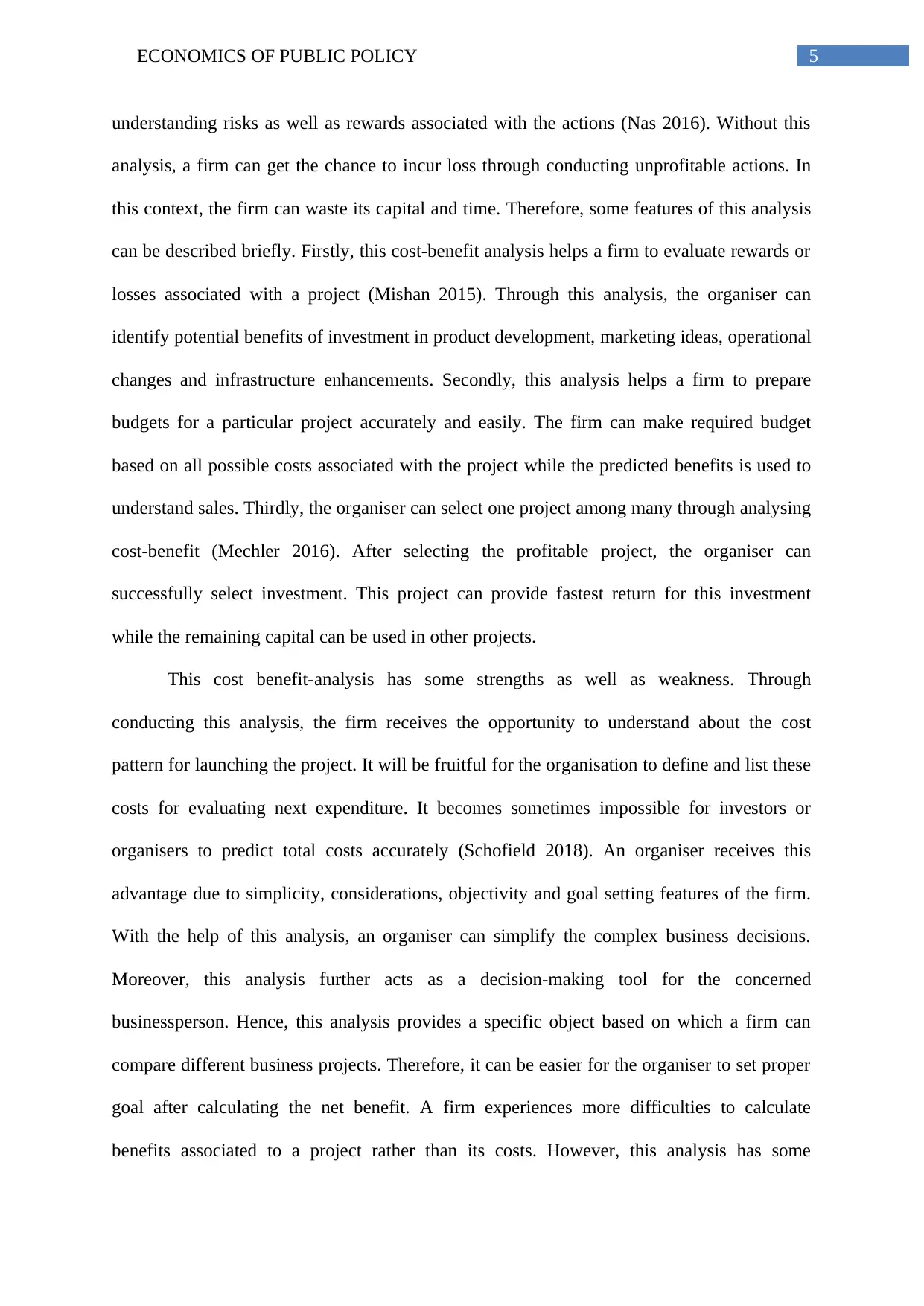
5ECONOMICS OF PUBLIC POLICY
understanding risks as well as rewards associated with the actions (Nas 2016). Without this
analysis, a firm can get the chance to incur loss through conducting unprofitable actions. In
this context, the firm can waste its capital and time. Therefore, some features of this analysis
can be described briefly. Firstly, this cost-benefit analysis helps a firm to evaluate rewards or
losses associated with a project (Mishan 2015). Through this analysis, the organiser can
identify potential benefits of investment in product development, marketing ideas, operational
changes and infrastructure enhancements. Secondly, this analysis helps a firm to prepare
budgets for a particular project accurately and easily. The firm can make required budget
based on all possible costs associated with the project while the predicted benefits is used to
understand sales. Thirdly, the organiser can select one project among many through analysing
cost-benefit (Mechler 2016). After selecting the profitable project, the organiser can
successfully select investment. This project can provide fastest return for this investment
while the remaining capital can be used in other projects.
This cost benefit-analysis has some strengths as well as weakness. Through
conducting this analysis, the firm receives the opportunity to understand about the cost
pattern for launching the project. It will be fruitful for the organisation to define and list these
costs for evaluating next expenditure. It becomes sometimes impossible for investors or
organisers to predict total costs accurately (Schofield 2018). An organiser receives this
advantage due to simplicity, considerations, objectivity and goal setting features of the firm.
With the help of this analysis, an organiser can simplify the complex business decisions.
Moreover, this analysis further acts as a decision-making tool for the concerned
businessperson. Hence, this analysis provides a specific object based on which a firm can
compare different business projects. Therefore, it can be easier for the organiser to set proper
goal after calculating the net benefit. A firm experiences more difficulties to calculate
benefits associated to a project rather than its costs. However, this analysis has some
understanding risks as well as rewards associated with the actions (Nas 2016). Without this
analysis, a firm can get the chance to incur loss through conducting unprofitable actions. In
this context, the firm can waste its capital and time. Therefore, some features of this analysis
can be described briefly. Firstly, this cost-benefit analysis helps a firm to evaluate rewards or
losses associated with a project (Mishan 2015). Through this analysis, the organiser can
identify potential benefits of investment in product development, marketing ideas, operational
changes and infrastructure enhancements. Secondly, this analysis helps a firm to prepare
budgets for a particular project accurately and easily. The firm can make required budget
based on all possible costs associated with the project while the predicted benefits is used to
understand sales. Thirdly, the organiser can select one project among many through analysing
cost-benefit (Mechler 2016). After selecting the profitable project, the organiser can
successfully select investment. This project can provide fastest return for this investment
while the remaining capital can be used in other projects.
This cost benefit-analysis has some strengths as well as weakness. Through
conducting this analysis, the firm receives the opportunity to understand about the cost
pattern for launching the project. It will be fruitful for the organisation to define and list these
costs for evaluating next expenditure. It becomes sometimes impossible for investors or
organisers to predict total costs accurately (Schofield 2018). An organiser receives this
advantage due to simplicity, considerations, objectivity and goal setting features of the firm.
With the help of this analysis, an organiser can simplify the complex business decisions.
Moreover, this analysis further acts as a decision-making tool for the concerned
businessperson. Hence, this analysis provides a specific object based on which a firm can
compare different business projects. Therefore, it can be easier for the organiser to set proper
goal after calculating the net benefit. A firm experiences more difficulties to calculate
benefits associated to a project rather than its costs. However, this analysis has some
⊘ This is a preview!⊘
Do you want full access?
Subscribe today to unlock all pages.

Trusted by 1+ million students worldwide
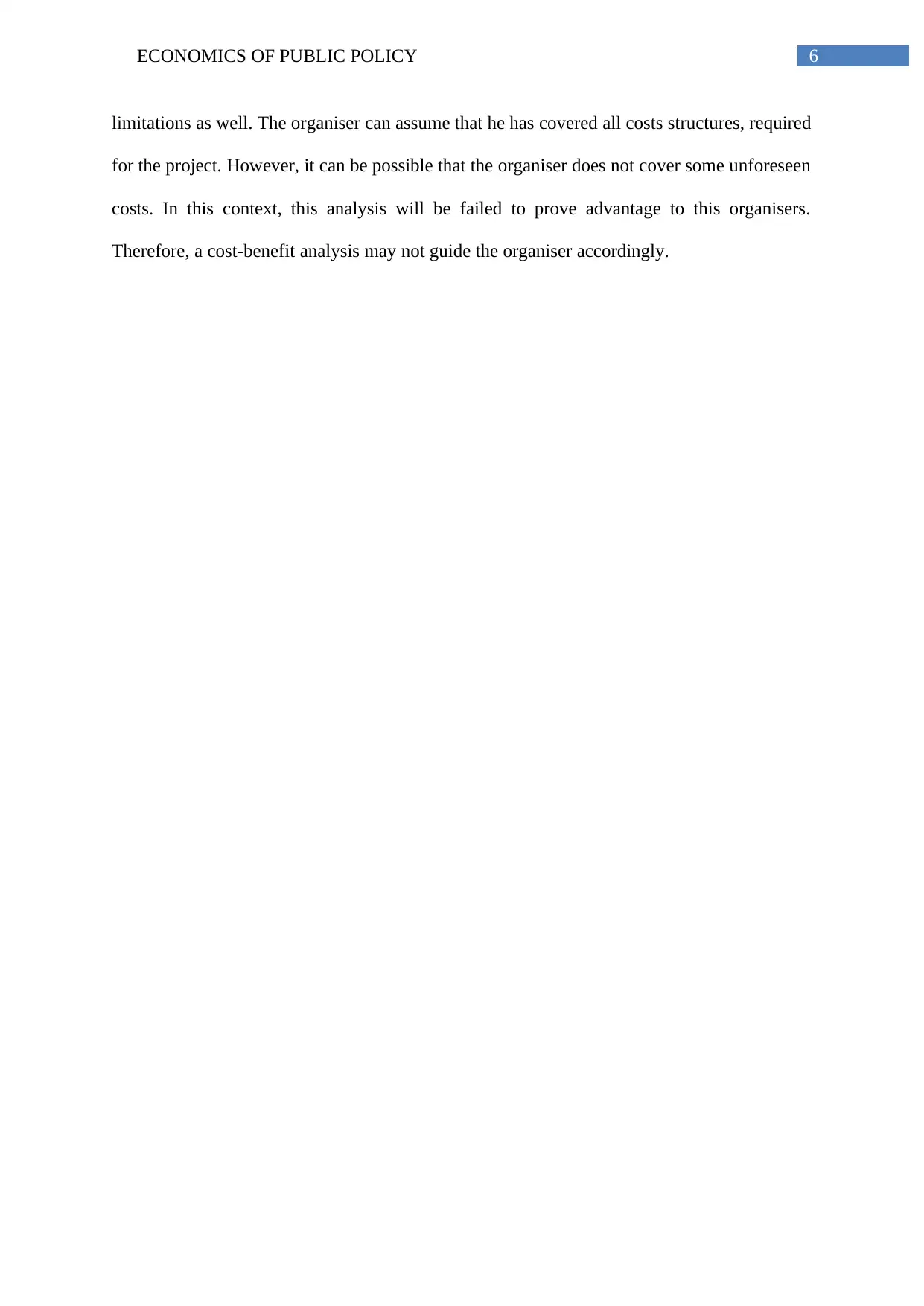
6ECONOMICS OF PUBLIC POLICY
limitations as well. The organiser can assume that he has covered all costs structures, required
for the project. However, it can be possible that the organiser does not cover some unforeseen
costs. In this context, this analysis will be failed to prove advantage to this organisers.
Therefore, a cost-benefit analysis may not guide the organiser accordingly.
limitations as well. The organiser can assume that he has covered all costs structures, required
for the project. However, it can be possible that the organiser does not cover some unforeseen
costs. In this context, this analysis will be failed to prove advantage to this organisers.
Therefore, a cost-benefit analysis may not guide the organiser accordingly.
Paraphrase This Document
Need a fresh take? Get an instant paraphrase of this document with our AI Paraphraser
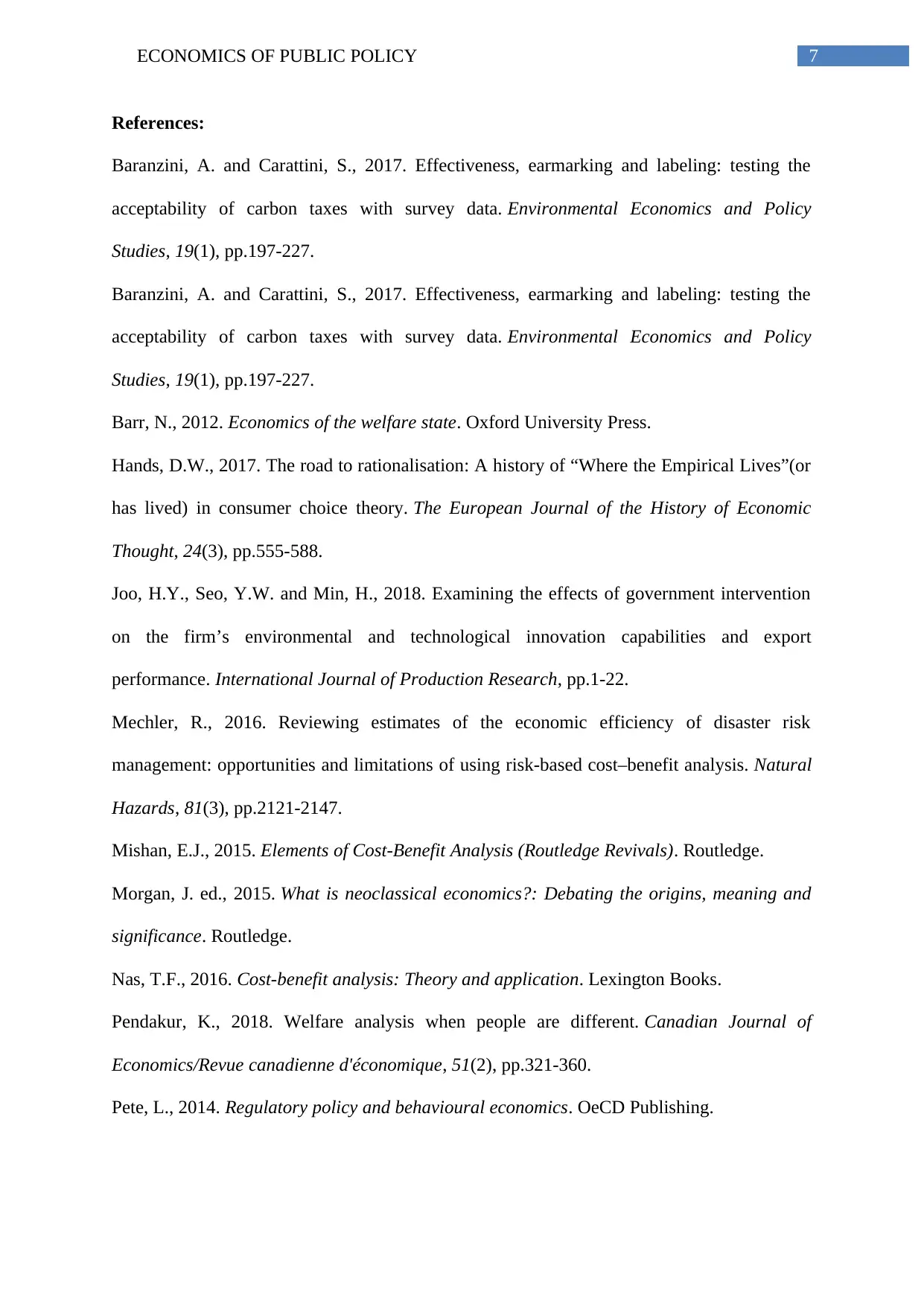
7ECONOMICS OF PUBLIC POLICY
References:
Baranzini, A. and Carattini, S., 2017. Effectiveness, earmarking and labeling: testing the
acceptability of carbon taxes with survey data. Environmental Economics and Policy
Studies, 19(1), pp.197-227.
Baranzini, A. and Carattini, S., 2017. Effectiveness, earmarking and labeling: testing the
acceptability of carbon taxes with survey data. Environmental Economics and Policy
Studies, 19(1), pp.197-227.
Barr, N., 2012. Economics of the welfare state. Oxford University Press.
Hands, D.W., 2017. The road to rationalisation: A history of “Where the Empirical Lives”(or
has lived) in consumer choice theory. The European Journal of the History of Economic
Thought, 24(3), pp.555-588.
Joo, H.Y., Seo, Y.W. and Min, H., 2018. Examining the effects of government intervention
on the firm’s environmental and technological innovation capabilities and export
performance. International Journal of Production Research, pp.1-22.
Mechler, R., 2016. Reviewing estimates of the economic efficiency of disaster risk
management: opportunities and limitations of using risk-based cost–benefit analysis. Natural
Hazards, 81(3), pp.2121-2147.
Mishan, E.J., 2015. Elements of Cost-Benefit Analysis (Routledge Revivals). Routledge.
Morgan, J. ed., 2015. What is neoclassical economics?: Debating the origins, meaning and
significance. Routledge.
Nas, T.F., 2016. Cost-benefit analysis: Theory and application. Lexington Books.
Pendakur, K., 2018. Welfare analysis when people are different. Canadian Journal of
Economics/Revue canadienne d'économique, 51(2), pp.321-360.
Pete, L., 2014. Regulatory policy and behavioural economics. OeCD Publishing.
References:
Baranzini, A. and Carattini, S., 2017. Effectiveness, earmarking and labeling: testing the
acceptability of carbon taxes with survey data. Environmental Economics and Policy
Studies, 19(1), pp.197-227.
Baranzini, A. and Carattini, S., 2017. Effectiveness, earmarking and labeling: testing the
acceptability of carbon taxes with survey data. Environmental Economics and Policy
Studies, 19(1), pp.197-227.
Barr, N., 2012. Economics of the welfare state. Oxford University Press.
Hands, D.W., 2017. The road to rationalisation: A history of “Where the Empirical Lives”(or
has lived) in consumer choice theory. The European Journal of the History of Economic
Thought, 24(3), pp.555-588.
Joo, H.Y., Seo, Y.W. and Min, H., 2018. Examining the effects of government intervention
on the firm’s environmental and technological innovation capabilities and export
performance. International Journal of Production Research, pp.1-22.
Mechler, R., 2016. Reviewing estimates of the economic efficiency of disaster risk
management: opportunities and limitations of using risk-based cost–benefit analysis. Natural
Hazards, 81(3), pp.2121-2147.
Mishan, E.J., 2015. Elements of Cost-Benefit Analysis (Routledge Revivals). Routledge.
Morgan, J. ed., 2015. What is neoclassical economics?: Debating the origins, meaning and
significance. Routledge.
Nas, T.F., 2016. Cost-benefit analysis: Theory and application. Lexington Books.
Pendakur, K., 2018. Welfare analysis when people are different. Canadian Journal of
Economics/Revue canadienne d'économique, 51(2), pp.321-360.
Pete, L., 2014. Regulatory policy and behavioural economics. OeCD Publishing.

8ECONOMICS OF PUBLIC POLICY
Schofield, J.A., 2018. Cost-benefit analysis in urban & regional planning (Vol. 20).
Routledge.
Schofield, J.A., 2018. Cost-benefit analysis in urban & regional planning (Vol. 20).
Routledge.
⊘ This is a preview!⊘
Do you want full access?
Subscribe today to unlock all pages.

Trusted by 1+ million students worldwide
1 out of 9
Related Documents
Your All-in-One AI-Powered Toolkit for Academic Success.
+13062052269
info@desklib.com
Available 24*7 on WhatsApp / Email
![[object Object]](/_next/static/media/star-bottom.7253800d.svg)
Unlock your academic potential
Copyright © 2020–2025 A2Z Services. All Rights Reserved. Developed and managed by ZUCOL.





